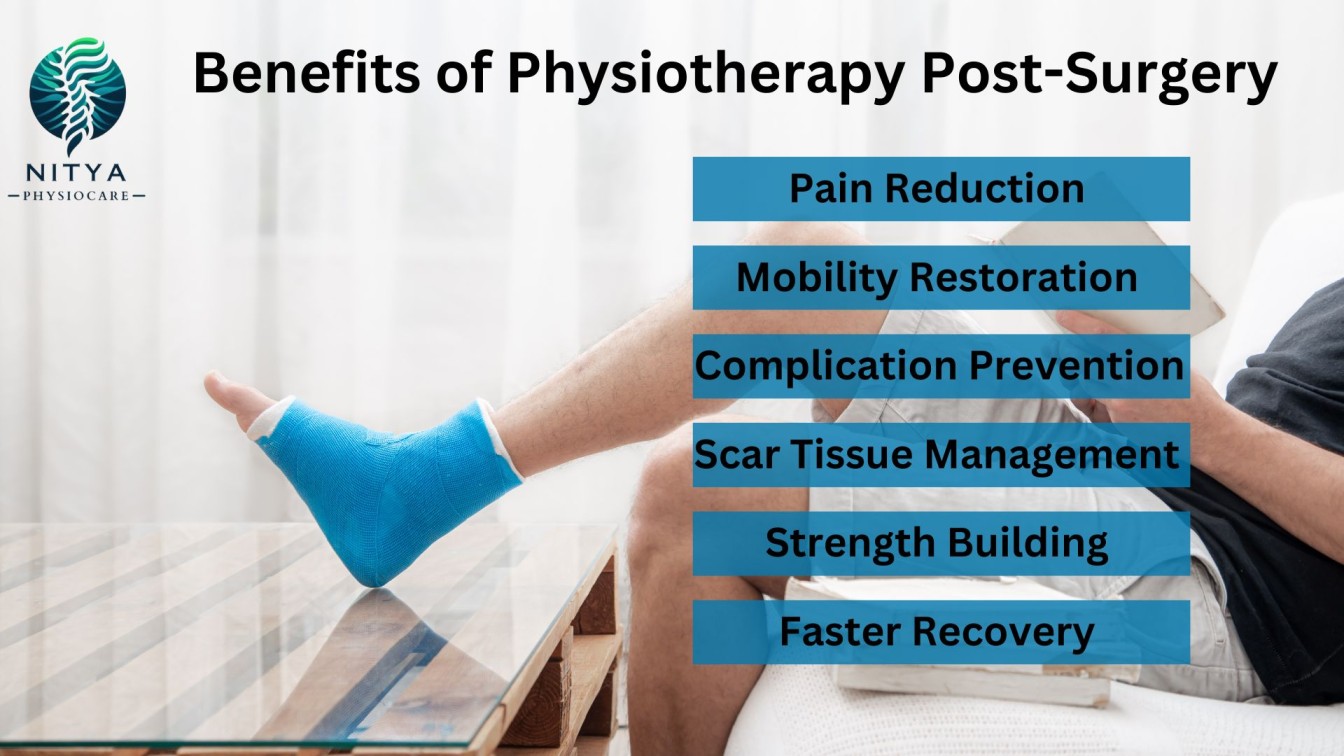Post-Surgery Recovery Simplified: How Physiotherapy Can Help You Thrive
Post-surgery rehabilitation in physiotherapy is a structured and personalized process that helps individuals recover and regain their physical function after undergoing surgery. It focuses on minimizing pain, improving mobility, and restoring strength and endurance to allow patients to resume their daily activities and overall quality of life.

Types of Post-Surgery Rehabilitation
-
Orthopedic Rehabilitation
- For surgeries like joint replacement (hip, knee), ACL reconstruction, or spinal surgery.
- Focus: Mobility, strength, and joint stability.
-
Cardiac Rehabilitation
- For heart surgeries such as bypass or valve replacement.
- Focus: Cardiovascular fitness, breathing exercises, and lifestyle adjustments.
-
Neurological Rehabilitation
- For surgeries involving the brain, spinal cord, or nerves (e.g., tumor removal, stroke-related surgeries).
- Focus: Balance, coordination, and restoring neural pathways.
-
Pulmonary Rehabilitation
- For lung surgeries or conditions affecting the respiratory system.
- Focus: Breathing exercises and improving lung capacity.
-
Abdominal and Pelvic Rehabilitation
- For surgeries like hernia repair or hysterectomy.
- Focus: Core strengthening and managing internal scar tissue.
-
Sports Rehabilitation
- For athletes recovering from injuries requiring surgery (e.g., rotator cuff repair).
- Focus: Functional recovery tailored to sport-specific activities.
-
Pediatric Rehabilitation
- For children undergoing surgeries like orthopedic corrections or congenital defect repairs.
- Focus: Developmental milestones and functional independence.
-
Amputation Rehabilitation
- For limb loss surgeries.
- Focus: Prosthetic training, balance, and strength adaptation.
Key Aspects of Post-Surgery Rehabilitation in Physiotherapy
- Pain Management: Techniques such as manual therapy, therapeutic exercises, and modalities like ultrasound or TENS are used to alleviate pain and reduce inflammation.
- Restoration of Mobility: Gentle exercises and stretches improve joint and muscle mobility, ensuring the operated area regains its full range of motion.
- Strength and Stability Training: Strengthening exercises target weakened muscles due to surgery, focusing on rebuilding muscular support and joint stability.
- Functional Recovery: Therapy is tailored to help patients perform daily activities, such as walking, climbing stairs, or carrying objects.
- Scar Tissue Management: Physiotherapists use techniques like soft tissue mobilization or massage to prevent excessive scar tissue buildup.
- Gait Training: For surgeries affecting the lower body, physiotherapists assist in retraining proper walking patterns and improving balance.
- Education and Home Exercises: Patients are educated on their condition, recovery timelines, and self-care techniques, complemented by home exercise programs.
Common Risks in Post-Surgery Recovery
- Infections
- Blood Clots (Deep Vein Thrombosis - DVT)
- Poor Wound Healing
- Pain and Stiffness
- Scar Tissue Formation
- Loss of Mobility or Function
- Mental Health Challenges
- Complications from Anesthesia
- Adhesions (Internal Scar Tissue)
- Muscle Weakness or Atrophy
Frequently Asked Questions (FAQs) in Post-Surgery Rehabilitation
- 1. Why is post-surgery rehabilitation important?
- Rehabilitation helps restore mobility, strength, and functionality while reducing pain and preventing complications like stiffness, blood clots, or scar tissue buildup. It also improves the overall success of the surgical procedure.
- 2. How soon should I start rehabilitation after surgery?
- The timeline depends on the type of surgery. In many cases, rehabilitation starts within 24-48 hours post-surgery under professional guidance. Always follow your surgeon’s advice.
- 3. How long does post-surgery rehabilitation take?
- Recovery time varies depending on the type of surgery and individual progress. It can range from a few weeks to several months.
- 4. Will rehabilitation be painful?
- Some discomfort is common as your body heals and adapts. However, physiotherapists aim to minimize pain and ensure exercises are within your tolerance levels.
- 5. What happens if I skip rehabilitation?
- Skipping rehab can result in stiffness, weakness, delayed recovery, and even long-term functional limitations. Rehabilitation ensures a complete and successful recovery.
- 6. Can I do rehabilitation exercises at home?
- While some exercises can be done at home, initial sessions should be supervised by a physiotherapist to ensure proper technique. They will provide a tailored home exercise program.
- 7. What should I wear during rehabilitation sessions?
- Wear comfortable, loose-fitting clothes that allow easy movement and supportive shoes.
- 8. Are there risks associated with rehabilitation?
- When done correctly, rehabilitation is safe. However, overexertion or improper technique can lead to setbacks. Always follow professional guidance.
- 9. How will I know if I’m making progress?
- Progress can be measured by reduced pain, improved range of motion, increased strength, and achieving functional milestones. Your therapist will monitor your progress.
- 10. Can rehabilitation improve my surgical outcome?
- Yes, proper rehabilitation enhances surgical outcomes by restoring strength, mobility, and functionality, allowing you to return to normal activities more effectively.
